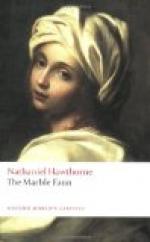“Dearest, dearest Miriam,” exclaimed Hilda, throwing her arms about her friend, “where have you been straying from us? Blessed be Providence, which has rescued you out of that miserable darkness!”
“Hush, dear Hilda!” whispered Miriam, with a strange little laugh. “Are you quite sure that it was Heaven’s guidance which brought me back? If so, it was by an odd messenger, as you will confess. See; there he stands.”
Startled at Miriam’s words and manner, Hilda gazed into the duskiness whither she pointed, and there beheld a figure standing just on the doubtful limit of obscurity, at the threshold of the small, illuminated chapel. Kenyon discerned him at the same instant, and drew nearer with his torch; although the guide attempted to dissuade him, averring that, once beyond the consecrated precincts of the chapel, the apparition would have power to tear him limb from limb. It struck the sculptor, however, when he afterwards recurred to these circumstances, that the guide manifested no such apprehension on his own account as he professed on behalf of others; for he kept pace with Kenyon as the latter approached the figure, though still endeavoring to restrain ’him.
In fine, they both drew near enough to get as good a view of the spectre as the smoky light of their torches, struggling with the massive gloom, could supply.
The stranger was of exceedingly picturesque, and even melodramatic aspect. He was clad in a voluminous cloak, that seemed to be made of a buffalo’s hide, and a pair of those goat-skin breeches, with the hair outward, which are still commonly worn by the peasants of the Roman Campagna. In this garb, they look like antique Satyrs; and, in truth, the Spectre of the Catacomb might have represented the last survivor of that vanished race, hiding himself in sepulchral gloom, and mourning over his lost life of woods and streams.
Furthermore, he had on a broad-brimmed, conical hat, beneath the shadow of which a wild visage was indistinctly seen, floating away, as it were, into a dusky wilderness of mustache and beard. His eyes winked, and turned uneasily from the torches, like a creature to whom midnight would be more congenial than noonday.
On the whole, the spectre might have made a considerable impression on the sculptor’s nerves, only that he was in the habit of observing similar figures, almost every day, reclining on the Spanish steps, and waiting for some artist to invite them within the magic realm of picture. Nor, even thus familiarized with the stranger’s peculiarities of appearance, could Kenyon help wondering to see such a personage, shaping himself so suddenly out of the void darkness of the catacomb.
“What are you?” said the sculptor, advancing his torch nearer. “And how long have you been wandering here?”
“A thousand and five hundred years!” muttered the guide, loud enough to be heard by all the party. “It is the old pagan phantom that I told you of, who sought to betray the blessed saints!”




